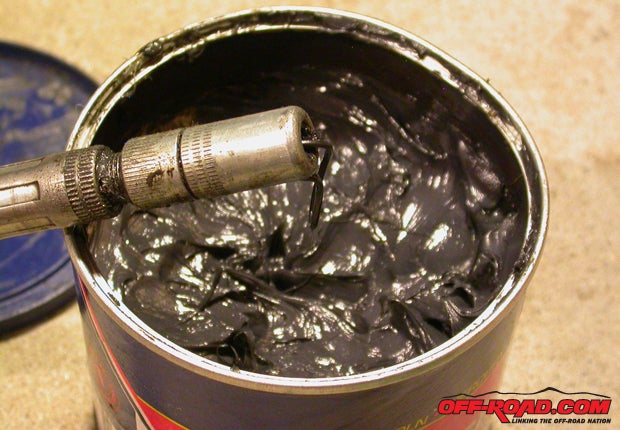
We’ve all been there – staring at the business end of an anti-roll bar or A-arm or a random Zerk fitting, thinking to yourself: “Self, what kind of grease am I supposed to use?” While the answer to that question varies wildly, the places we all seek out those answers do not. Do you ask a mechanic? Which mechanic? What about the guys at the off-road shop that you bought the parts? They’ve probably sat and stared at the same parts you’re staring at. How about you get a hold of the people who make the grease and see what they suggest?
Of course, there’s more to this story than “What do I use?” That’s because there are about a bajillion greases on the market out there, and even though you’ve used one kind or another for this or that application, were you right to do so? Did you know what you were doing? Does someone else know more about grease than you?
This could have been a greasy this-for-that list, but you wouldn’t have enjoyed it very much. Instead, we reached out to people who know a few things about greases – especially in off-road settings – and knocked them about with our greasy questions. Most of these greasy folks work on the money-making side of the wrenching business (rather than the money-spending side, where the rest of us live), so they had lots of tales about greases they’ve known and loved, how to show grease a good time, and what they recommend when it’s time to grease: Chris Barker with Royal Purple; Brandon Schaub and Gerard Wagner at Tony’s Lube & Tune in San Diego; Jason Edwards and Jeramie the Mechanic at ORW in El Cajon, CA. This casual collection of mechanics and grease monkeys, plus a real-life manufacturer’s rep, had a lot to tell about different greases. Will any of it answer your questions?
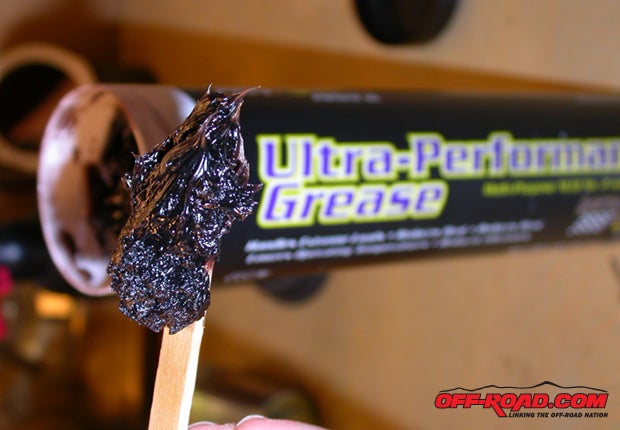
It Begins: What Grease for Urethane Bushings?
Speaking of staring, this story sprung up while glaring at a set of urethane bushings for some upper A-arms on a Toyota. While we had used the as-specified grease for the arms when they were installed (a sticky goop supplied with the arms), there wasn’t a lot and we’d used it up, and the bushings had started squeaking again. The Zerks feeding those bushings were begging for a shot of grease from the gun full of bearing grease in the garage, and we tried a shot of it, but it didn’t last. The high lateral loading and constant movement of the upper A-arm worked the axle grease right back out of the bushing, and they began squeaking again in a matter of days.
In search of suggestions, we paid our buddies at Off-Road Warehouse in El Cajon a visit. Jason and Jeramie agreed that a Lubrication Engineering grease they called “gorilla snot” or “the red stuff” was good for this application. They’d used it before – the official name was Almagard – and the variable-purpose grease had been very durable. It was a tacky, lithium-complex grease that water didn’t bother much (good for the summer high-mountain, creek-fording season). Jason said he’d been recommending it for years, and he’d used it for everything from springs, rubber, poly, and the ceiling fan in his living room. Jeramie at ORW added that he likes to use the red stuff on aftermarket and HD truck ball joints.
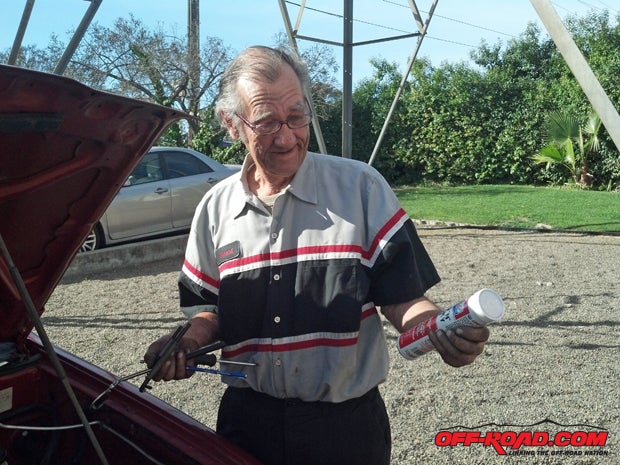
To get some of the science behind our grease questions, we sought out Chris at Royal Purple – he’s been on the manufacturing end of the grease business for 10 years. When we asked Chris the poly bushing question, he smiled and stated that he gets it a lot. He suggested Royal Purple’s Ultra Performance Grease #2, which is good for most chassis points that need the grease to stick around (and is made in the U.S.). He added that the numbers on grease identify the firmness of the grease, and that almost all multiple-application greases are #1, 2 or 3 (mostly #2), and the lower the number, the thinner the lube. A #0000 grease flows like oil, while you could mug someone with a #6 grease. Clunky “brick” greases like a #6 are used in situations where heat will melt them, such as with steam engines, oil wells or a compound mill.
Chris has been a Texas oil eater for a long time, so he had a lot of knowledge to share:
• A grease is the combination of a lubricating agent and a suspension agent.
• There are very few greases that are bad for polyurethane.
• It’s an old wives’ tale that poly elastomers don’t like petroleum-based lubes. Most polyurethanes or Delrin are stable and inert in the presence of mineral lubes.
• Rubber, on the other hand, doesn’t get along with the dino-based stuff – just leave a rubber bushing in a rock-juice bath for a few weeks and watch what it does.
• The color of a grease only means someone wanted to make it that color: there are very few chemical causes for what’s colored what (that’s why ATF is red, for example – someone said so). This even goes for Royal Purple products – they’re purple because Royal Purple isn’t named Royal Green.
• The only “sort’a” exception to grease coloration is greases with molys in them: molydnum or molydnum disulfide. The graphite in these means they’re always going to be the color of graphite.
• Sticky greases are sticky to keep the lube where it was applied. A tackiness agent in the grease does the heavy lifting; in some cases, it’s formulated to “string” as a part of its function. The type of stickiness is usually specific to each application, and temperature tends to affect a grease’s stickiness.
• Check parts manuals for exact grease instructions. It’s common to see a thickness requirement (#2), but specs about specific greases for specific bushings are rare.
Gerard at Tony’s Lube & Tune in San Diego has been wrenching longer than most of us have been alive. When he was asked the same question about polyurethane bushings, he simply declared, “Something that will stick around. And USE it – don’t be cheap.” He agreed that checking the part manufacturer’s specs was a good idea, and then reminisced about a grease Chrysler used to make for its front-drivers in the ‘90s that was the stickiest he’d every seen (even tackier than the #2 Lucas “Red “N” Tacky” grease he uses now as his “sticky” grease). Gerard said the Chrysler grease was “stupid-tacky” – staying in place “forever” – and was ideal for high-temp and high-pressure applications. Gerard proceeded to bitch for five minutes about not being able to get it anymore, which made the effort of interviewing him totally worthwhile.
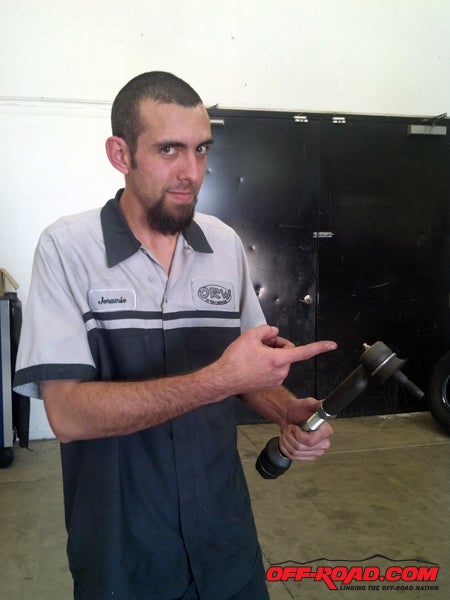
Getting Grease on Bearings (and Keeping It There)
While Gerard was sounding off about the worldwide conspiracy to keep him from having good grease, Brandon from Tony’s had a few minutes to talk about how much he enjoys packing axles and bearings. He’s a boat guy, and has gotten hooked on using marine grease for almost all big boy bearings instead of regular bearing grease. This went doubly for extra-load, heavy-duty applications and trailers. He does a 100%-pack on boat trailers and any vehicle that might see deep water (trail guys: are you listening?), because any holes in the grease pack of a bearing will let water in – Brandon likes to make sure the water doesn’t have a place to go. He’s also a big fan of using a Bearing Buddy to keep whatever grease is at hand on the bearings where it belongs (trailer-supply stores sell these).
Jason and Jeramie at ORW had the same advice about packing bearings – a little grease on the outside won’t do the job. If you can’t pack bearings by hand, get the tool and use it. Jeramie likes what he called “standard blue” high-temp wheel bearing grease for most axle and high-load bearing applications (and insisted that you need to use a high-temp grease that’s made for bearings), though he suggested the stickier Almagard (the red stuff) for trucks with small bearings like Rangers, because they move faster and tend to cook and subsequently sling wussy greases. Jeramie added that “the red stuff” is good for applications with a lot of heat because of its stickiness, while he likes Swepco 101 moly grease for U-joints because it works to keep water out, and the moly cuts down on friction – even when the grease is gone there’s still a little graphite hanging around (just in case).

Jason added that a popular constant-velocity (CV) packing trick that many SoCal sand and buggy builders like Jimco and Alumicraft use is to fill the CVs with a 50/50 mix of Swepco 101 moly grease and Bel-Ray’s astronomically-priced anti-seize, packing them in super-messy handful-of-goop fashion. The 50/50 blend goes in as a paste, won’t separate, and stays there as long as the boot is intact. He said that with some axle grease, the same combo works for standard half-shaft CVs, but stated that if you’re going to try it, bring your purse because it’s not a cheap mix to make. Gerard at Tony’s cautioned against mixing moly greases with lithium greases, however, and then bitched about moly greases for five minutes (again, worth the price of admission).
Some More Science - Greascience
Chris from Royal Purple cautioned everyone who’s seeking, using or recommending greases that words have meaning. Call a grease by its specific name – what it is – and avoid using slang terms. Moly could be molydnum, or it could be molydnum disulfide – they’re not the same thing and both do different things. He also reminded us that grease is not oil – grease is an oil plus a thickener, and that thickener (with whatever else has been added to the grease’s formula) is designed to hold the lube somewhere, make it behave in a certain fashion, keep some in reserve, or stop it from leaking. You use greases when you can’t keep the oil from leaking because grease stays put under pressure, and in extra-hot applications. Mechanical devices need to be able to count on grease to perform, maintaining its film strength and sticking around, and good formulas mean good performance. Chris was also adamant that you get what you pay for with any grease product, which is why Royal Purple sells a lot of grease.
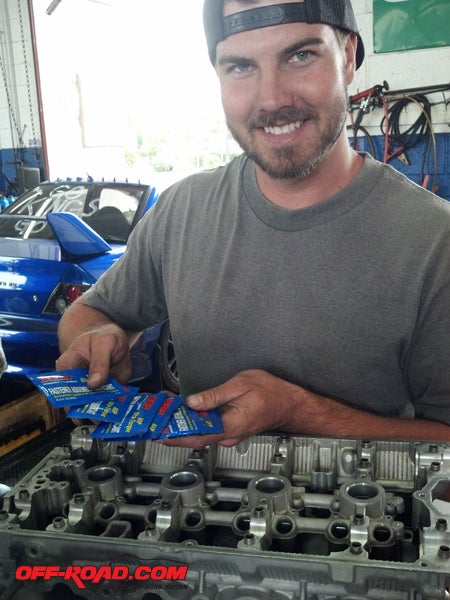
Some more thoughts about grease from the guys:
• When you inject grease with a pump grease gun – which can exert a lot of pressure – rubber and urethane bushings can be “mushroomed” out of place if there’s no route for the injected grease to flow around the bushing. Be sure to give the grease room to move without pressurizing and distorting the bushing. In case you do overpressurize a bushing, yank the fitting (Zerk or otherwise) to see if the bushing will depressurize itself.
• Jeramie likes anti-seize for parts that are hard to service, like leaf spring bushings.
• Coat replaceable poly bushing with your choice of grease when you’re installing them.
• For the slip-joint in a driveshaft, use a high-temp wheel bearing grease.
• We started seeing sealed ball joints in the ‘90s, and this trend may spell the end of Zerks on new cars. Gerard suggested it was Mercedes-Benz’s fault, and then spent five minutes bitching about German cars (keep in mind, his last name is “Wagner”).
• Don’t feel silly hoarding the spare grease packets that come with suspension parts – Brandon’s been doing it for years, especially the grease that comes with poly parts.


 Your Privacy Choices
Your Privacy Choices